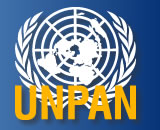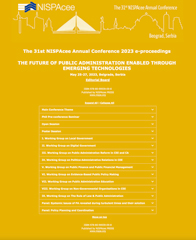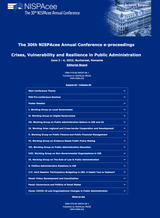PROGRAMME EVALUATION
1. INTRODUCTION
The National Association of Schools of Public Affairs and Administration (NASPAA) in
collaboration with leading schools of public administration and public
policy in the United States, and with the Network of Institutes and
Schools of Public Administration in Central and Eastern Europe
(NISPAcee), applied in
year 2000 to USAID for a three-year project to support processes of
improving public policy-making and administration, to strengthen
long-term cooperation among governments, academic institutions and NGOs
to address social and economic needs, and to leverage this capacity in
support of USAID development goals in Central and Eastern Europe (CEE)
and the Newly Independent States (NIS).
The primary focus of the project was to implement a program of applied
policy research linking governments and higher education in the region,
providing added technical capacity for government problem-solving and
building civic capacity through sustainable partnerships between
government and higher education. The
second part of the project was providing technical assistance efforts
to aid emerging higher education institutions in the region in
strengthening their capacity for government partnerships and for
building a new public service.
The project drew heavily on the existing capacity within the NISPAcee
network which has emerged as an NGO, allowing it to leverage the
resources of stronger public administration (PA) programs that have
successfully developed in the region. Its main principle was a
partnership, primarily between schools, institutions and public
administration in the CEE region, and between schools and PA
institutions of the CEE region and USA.
2. MAIN GOALS OF THE PROGRAMME
The
primary activity of the project was to implement a program of applied
policy research linking governments and higher education in the region,
providing added technical capacity for government problem-solving and
building civic capacity through sustainable partnerships between
government and higher education. These
applied policy research projects and ancillary activities strengthening
both public administration education and the network of PA schools in
the region were designed to achieve five major goals, as follows:
Goal 1:
Address key public policy problems in Central and Eastern Europeand the NISin order to promote social and economic development and democratization.
The project complements USAID’s goals of "creating
an enabling environment supportive of development and humanitarian
actions by both individuals and communities,” "encouraging investments
in human and institutional capacity at the local level,” and "building
strategic partnerships at state, society and market actors through new
linkages at the community, national and society-to-society levels.” (USAID Strategic Plan)
"USAID’s success depends on the quality of its partnerships.
Accordingly, it actively seeks to improve the quality of its
partnerships and cooperation among partners.” (USAID Strategic Plan) The
partnerships this project aims to improve will create linkages between
American universities with a strong sense of democratic principles and
those in the developing world still novice to the ideas of guaranteeing
civil rights, protecting civil liberties and building transparent
government institutions.
As mentioned, the project:
- Supported USAID goals in Central and Eastern Europe and in NIS countries to foster democratic governance and develop the public systems necessary for economic development and policy-making.
- Helped to improve the quality of public administration and public
policy analysis and research available to decision-makers at all levels
of government in NIS countries, and to strengthen the cooperation among governments,
academic institutions, and NGOs to address social and economic needs.
Goal 2:
Build partnerships between higher education and government in Central and Eastern Europeand the NISas a means of strengthening government problem-solving and civic capacity.
The project focused on creating new and strengthening existing linkages between government and the academic community aimed at providing effective solutions to complex public policy problems and, in so doing, further legitimizing the role of civil society in the solving of public policy. The specific public policy problems addressed by the project were brought forth by participating university-government partnerships during the course the study.
In particular they addressed substantial changes in the capacity to
deliver public services and design public policies that have emerged
from democratization and the emergence of market economies. These structural changes included changes in:
- The organization of government agencies themselves called for by the
democratization of civil service recruiting, civil service job
classification, public access to information, transparency, automating
personnel functions, development of policy analysis capabilities, etc.; and
- The adaptation of public services to a new market economy—management
of public-private partnerships, formation of NGO partnerships,
introduction and management of devolution, market regulation,
anti-corruption initiatives, etc.
Goal 3:
Support further development of public administration education in Central and Eastern Europeand the NISin an effort to train new generations of public sector leader, informed by international developments in public administration.
The other objective of the project was enhancing the capacity of NISPAcee institutions to carry out successful programs of teaching, applied public policy and management-oriented research, training and service. This issue is extremely important as most public administrators in CEE and NIS were trained before democratization and the market economies emerged in the region, and most public administration education was oriented to supporting centralized governments and economies. Democratization and market economies require different administrative systems and capabilities: emphasizing devolution, management of partnerships, transparent systems and performance monitoring. These new management skills are needed by actors in all sectors—public, non-profit and private—that now play important roles in public services. In the West, schools of public administration train managers in these areas who enter all sectors and frequently cross back and forth among them.
In the CEE and NIS,
new public administration programs just emerged to produce trained
administrators for all sectors who have studied these new ideas. One
consequence of the project was to help strengthen these institutions by
supporting their scholarship and by modeling its implementation and
application in the classroom.
Goal 4:
Leverage local capacity provided by NISPAcee by forming a sustainable partnership and building on past USsupport to Central and Eastern Europefor meeting mutual development objectives in the region.
The other issue was to leverage and enhance capacity already established in the region of NISPAcee institutions as an established network in order to sustain USAID objectives in Central and Eastern Europe and thus advance them in the NIS, reinforced by an effective and well-managed regional association, the NISPAcee.
The merits of having strong private professional associations for
scholars and practitioners of public administration were already
discussed in these goals. Getting
such groups started and institutionalized can, however, be very
difficult, because of the resources required to become established, gain
a reputation for effectiveness, and build member "loyalties.” With
past Western support, NISPAcee has crossed these initial hurdles and is
in place to serve this role for academic programs in Central and Eastern Europe and the NIS. It
is recognized by numerous international bodies—the International
Institute of Administrative Sciences, OECD, UNDP and others—as the best
one to play this role.
Goal 5:
Engage US universities in a new generation of development partnerships.
The last but not least important issue was to engage US university programs of public administration, public policy, and public affairs with their counterparts in Central and Eastern Europe and the NIS in a new generation of development partnerships by building a collaboration in policy studies in the region and on mutual discussions of curriculum and research trends. The new generation of development partnerships referred to here are partnerships based on the linking of networks of institutions toward goals that have region-wide implications.
Public administration in CEE and NIS as well as the US and other Western regions are now addressing a much more common set of
questions. These questions are grounded in democratic institutions and
market economies such as issues of transparency, rule of law,
devolution, management of public private partnerships, etc. This shared
learning that encourages the establishment of continuing linkages
between individual NASPAA and NISPAcee member institutions for carrying
out effective public policy and management-related research and
evaluation, curricular development and other related matters becomes
more and more important.
3. LIST OF PROJECTS
As already indicated, two types of projects were realized within the frame of the programme:
A) Applied policy research and management projects
B) Technical assistance projects
In following text we provide full lists of all approved projects, including important info about the topic, partners and timing.
3.1 APPLIED POLICY RESEARCH AND MANAGEMENT PROJEcTS
In the area of applied policy research and management projects, the selection committee approved ten projects during the original timeframe, three projects during the second extension of the programme, two projects during the third extensions and one project has been expanded. This means that in total 16 projects were realized during the duration of the programme. The list of all projects is provided by the following table.
3.2 TECHNICAL ASSISTANCE PROJECTS
In the area of applied policy research and management projects, the selection committee approved four projects during the original timeframe, and two projects during the extension of the programme. This means that in total six projects were realized during the duration of the programme. The list of all projects is provided by the following table.
3.3 Projects evaluation
As the part of our report all individual projects are evaluated (see Annexes 1–22). The evaluation follows the same structure in all cases and its main parts are:
- Project description by providing basic data characterizing the project.
- The defining of purposes and goals of the project.
- Evaluation of project realization/implementation processes.
4. GENERAL EVALUATION OF THE PROGRAMME
5. CONCLUSIONS
Annexes 1–22: Reports of all individual projects




 Price:
Price: 








